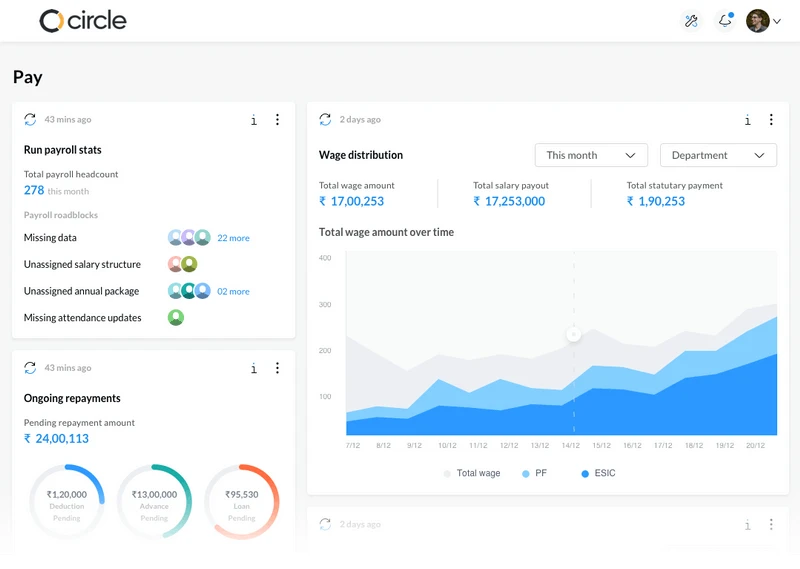Regardless of whether you’re responsible for a small team of six, or you’re overseeing a department team of a few dozen, improving your employees within the workplace is always needed.
There are plenty of ways in which you can influence your staff to do better within their roles and for the company in general.
One such way is through performance improvement plans. It not only provides the employee with the feedback needed to progress in their role but it can also do a lot for the business in general.
With that being said, let’s look at how a performance improvement plan can benefit your employees.
What is a performance improvement plan?
An employee performance improvement plan ( PIP) is a formal document expressing any continuous or regular patterns of poor performance by an employee.
The employee PIP usually outlines a specific timeline for the employees to regain a level of standing at the organization.
A performance improvement plan is often written by the worker’s manager or supervisor, which is then submitted internally to HR.
The plan usually involves certain objectives that need to be met and these tend to come with a deadline too, which is up for the manager to decide.
This document also outlines what should happen if the employee fails to reach the objectives and their performance continues to not meet the expectations of the manager.
When it comes to a performance improvement plan, it can be flexible to fit any kind of scenario in which there might be issues with employees and their performance. It might be something you introduce for those in their probationary period, for example
It’s a way to encourage your employees to take their work seriously and to make the necessary changes needed to remain within the company.
An employee PIP is used by any organization when they noticed a pattern of poor performance or maladaptive behavior in an employee.
It is usually regarded as the initial process of dismissing an employee, as a probationary period.
It can however be useful for both the employee and the company. It can be a kind of signal from the company that they want to keep the employee and is thus giving them an action plan to improve their job performance.
It is a structured approach that targets improvement through talent management strategy and formal documentation.
The management or human resource team will work with a particular employee to form an action plan and find the key areas for improvement. Performance reviews are vital for the ongoing employees and reviews with the PIP spectrum are no different.
You need to ensure that the underperforming employee is sticking to the performance action plan and your judgment on the progress should be fair.
Regular feedback on the performance is essential and you need to take disciplinary action as well if they are not doing their best for improved performance.
The ultimate goal for any employment PIP should be to find an evergreen solution for the employee, their professional development, and what’s best for your organization.
When should you implement the Employee Performance Improvement Plan?
When you notice that any employee in your organization is suffering, that is when you initiate a plan. As a manager, you should be able to pick up on the signs of an employee whose level of performance is not up to the mark.
Decreased engagement, decreased productivity, not being punctual, taking more time off than necessary are all signs of an employee with low performance.
You should start with effective PIP when there is a continuous streak of negative performance.
The benefits of an Employee Performance Improvement Plan?
It might seem to some that a performance improvement plan could just be avoided by firing the employee. However, not all employees start on the right footing, and sometimes, losing the employee might end up hindering your company’s performance too. There are benefits of a performance plan that can help you and your employee.
There are times where an employee can become complacent or disgruntled with the job they have and often enough, they’re overdue a performance update or review.
By putting a performance improvement plan in place, you’re giving the individual a chance of redemption and to make it easier for your company as well.
Here are some of the benefits that can come with implementing these plans for your employees.
1. Saving time, money, and resources
According to Toggl Hire, most small businesses will spend a staggering 40 hours on tasks that do not generate income, which includes hiring. There’s a lot of time wasted on recruitment when it’s not always needed and can be avoided.
The cost and resources used when recruiting too can also cost a fortune and that’s all spent in the hope that you’ll be able to find the right individual to join the company.
Not every business can find someone on the first go and may need to do several recruitment drives before finding someone, especially for senior job roles.
Most employers will want to minimize the employee turnovers that they have, keeping the percentage as low as possible. Helping existing staff members to reach an acceptable performance standard through a plan like this can be a much more cost-effective way.
It eliminates all the expenses and expenditures that are needed when firing staff and replacing them with new hires. There’s also the extra costs saved from having to train new staff. With those who do a performance improvement plan, there’s likely to be training but not to the extent that a new employee would likely need.
So if you’re a small business looking to keep spending as low as possible, then a PIP would be a more appropriate solution.
2. Provides a better company culture and atmosphere
Your employees rely on you for an income but for many, it’s a career that they wish to thrive in. Most employees will hope that should they fall on hard times or go through a rough patch, they’d receive support from their employers. Performance improvement plans shouldn’t always be seen as a bad thing.
Having a PIP in place for when employees aren’t doing well, it’s showing a willingness that you’re believing in an employee’s ability to change and improve.
That trust and support from an employee’s perspective can be a real sign of respect and the rest of the company workforce are likely going to see this the same way.
With that being said, it ends up being beneficial to the company culture, and that you’re able to often get a second chance to redeem yourself. That is an atmosphere that you want in a company, knowing that if you fail, there’s a chance to get back up and try again.
Effective performance improvement plans aren’t just for badly behaved employees. They can also be appropriate for workers that want to progress within the company and maybe struggling to navigate that without the right plan or objectives in place.
Showing belief and commitment to your employee is always going to have its benefits and it can, for many staff members, help to reach long-term career goals. As a result, you’re likely to see employees that are motivated and more productive in their efforts to progress up the ranks.
3. More effective than reviews
With reviews, these tend to be annual meetings whereby there aren’t any consequences put in place, should the employee not meet their goals or objectives. There’s also a lot more critical that can come across when giving a review, even if the comments mentioned are meant to be constructive.
Not every employee will see it that way and may find the review to be more counter-productive for them too.
With PIPs, there’s no way of getting around it and it gives the employee a clear image of what isn’t going right. It outlines what they’re failing to achieve and how it can be improved.
Failure shouldn’t be a bad thing to experience but it’s what you do next that really counts.
So whilst reviews might work for some employees, for those who need to be encouraged to try harder, performance improvement plans are definitely the way forward.
4. Reduces Liability
If any time in the future, the employee tries to win by claiming an unlawful termination or any other instance on similar grounds, PIP acts as a formal document starting the employer’s dissatisfaction with the employee.
While this protects the employers, you need to make sure that when explaining an employee on the improvement plan, you convey your message in such manner that
How to improve the effectiveness of an Employee PIP?

If you’ve never created a performance improvement plan before, then it’s worth understanding how to structure it in the right way.
1. Define the goal
Firstly, there needs to be a goal. This goal is what the manager wants to achieve with the employee. It’s the problem that is highlighted and once a goal has been set, then the objectives come next.
Now when it comes to the objectives, it’s important to be detailed in how these tasks will ultimately fulfill the goal. With that in mind, try to define exactly what is needed. Here’s an example:
Unprofessional employee behavior in the workplace, arriving late and behaving rudely towards others.
The goal would be to correct the behavior according to ot the company policy and to be professional within the workplace. The objectives might be to ensure the employee arrives on time to work and treats everyone in the workplace with the respect they deserve. An action is then put in place to put these objectives in motion such as training.
With any PIP, you’ll want to have metrics to assess their progress and to measure how well they’re doing. Some will be easily measurable and others might be subjective.
2. Determine what’s acceptable
A tip when it comes to creating the plan is to collaborate with the employee and perhaps HR to word everything appropriately and to conclude what is acceptable progress. It’s important that both the manager and employee understand when goals have been achieved and that no wires are crossed in the process.
3. Create a schedule for check-ins
Monitoring the progress can be done by scheduling regular check-ins with the employee. This might be done with just the manager and the employee in question, or HR may want to be involved. By creating a schedule, it gives that pressure of a deadline and it may encourage the employee to work harder as a result.
4. Be clear with the consequences
With any PIP that has consequences, be clear and concise in what these mean. The employee who may be misbehaving badly in the workplace needs to know the full extent of the outcomes should nothing change.
Being faced with the likelihood of losing their job or being suspended is enough for most to get their act together and make the changes needed.
5. Communication
This plan is a collaborative process. Everyone in the organization should have the liberty to talk freely and share their weaknesses.
As a manager, you need to provide clarity about the expectation you have from an employee. And as an employee, you need to keep in contact with any problems you may face when following the PIP.
Also in such cases employee feedback of how much they’ve understood the PIP is crucial.
6. Root Causes
There could be the underlying root cause for the weak performance of an employee in your organization.
Perhaps they are dealing with some personal issues, or they something troubling them in their professional life. Whichever maybe the case, you need to talk to your employee honestly, give them respect and positive encouragement.
Discuss how all these issues are hindering their performance and find ways to improve it.
7. Structure
This will consist of a timeline that you want the employee to follow to bridge the performance gap. One-on-one meetings with the employees regularly, and tracking their performance could go a long way.
8. Positivity
When an employee is placed on a PIP, the one thought that crosses their mind is: they are bad at their job.
As a manager, it is your duty to make sure that the employee feels like a valuable member of the company. You need to emphasize the positive sides of their employment.
What can go wrong with an Employee Performance Improvement Plan?
Having any form of development conversation is not an easy task. So if you come across anybody that says otherwise, they are either lying or they are doing it wrong.
Even if you can put your cards on the table with honesty and respect, your employees might feel defensive and put off.
Hence, the awkward conversation!
Here are a few ways you can ease the potential sting:
1. Document behaviors and accounts of performance- If you have proof of performance deficiency of an employee, you need to show that to the employee. This acts as proof that you are not making any vague assumptions.
2. Make sure it’s a trend – Anomalies that we expect from time to time in employees’ performance are normal. You need to find a trend in the performance levels to take corrective action. Performance deficiency or undesirable behavior should be trends to place an employee on PIP.
3. Focus should be on performance – Any kind of personal attacks should not be in the picture when placing a worker on PIP. The focus should be on improving the performance standard only.
Performance improvement plans are a great strategy for your business
Having a performance improvement plan in place for troublesome employees or those looking for growth within the company can be a great strategy for your business. It can help retain the employees you have and help to save a lot of hassle with having to fire them, and then hire someone new.
Try implementing PIPs and hopefully, you’ll be able to encourage more of your employees to make necessary improvements as and when it’s needed.
If you’re looking for a performance appraisal software sumHR’s all in one HR Software comes with a 360 performance management system that helps rally everyone around your mission, turn slackers into performers and set the stage for complete performance appraisal. So no matter what the country we are here to hel you get started. Book your free demo for sumHR now or start your 7 day trial.








